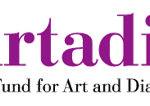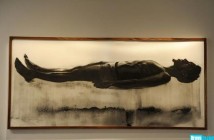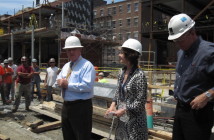A CONVERSATION WITH LILA KANNER, DIRECTOR OF PROGRAMS @ ARTADIA
Artadia Boston’s cycle has come around again. This is the second year for our city and I had the chance to speak with Lila Kanner, who is the Executive Director of Artadia, about her role with the program and how they are coming along as they hit their ten-year anniversary. We spoke just before the information session at the Mills Gallery at the BCA on Monday, June 1st. Applications are due by 11:59 PM EST on June 15th. For more information please visit Artadia.org.
-
James Nadeau: Now I know a bit about Artadia, having known a few of the people involved, but why don’t we talk about the history of the program. A lot of this is on the website but if perhaps we can talk about your role. Have you joined fairly recently or?
Lila Kanner: I have actually been at Artadia for three years. And this year is the ten-year anniversary of our first awards program. The program was started in San Francisco, in the Bay area, and founded by Chris Vroom, who’s still the president of our board. We have a national board of about fourteen individuals around the country who support Artadia. But beyond that the organization was founded with the core mission of supporting artists and communities. We have a consistent two level type of activity happening simultaneously so there’s always the local opportunities that we are providing artists and working within the community creating relationships with arts institutions, individuals, collectors, artists, as well as arts advocacy groups, local schools, etc, really all of those parts of the ecosystem. And then through the awards program to recognize and confer that merit based recognition opportunity on artists within the community. At the same time that localized activity is going on we have the exhibition and publication program in addition to the awards program. We are also working on a national level to provide opportunities to artists who have won our awards as well as to bring the attention to the community at large. So by launching a Boston program our hope is not only are people going to start paying more attention to these artists who, in 2007 there were ten awardees and this year there will be seven, but then in addition to get people to start thinking that Boston is a place to access culture and that there is a lot of important contemporary work happening here. So the program has really been designed and always has functioned to do those things simultaneously. And ten years later I think Artadia is still very much acting with the same premise. Which is: we are about relationship building, about exposure, exhibition programs or through catalogs, or through programming or whatever it is, it is to provide artists over the duration of their careers that type of access. What is really a core part of Artadia that differentiates us from other programs is that once an artist wins an Artadia award they are part of our network, forever.
JN: I find it interesting that while it is this local based program, the drive is to be both local and national simultaneously. Which seems to be a really difficult balance to maintain. Because what I am beginning to realize is that you can really live anywhere anymore and be a successful artist. You don’t have to live in New York. But there is still an interesting push and pull between the local and the national, with New York still believed to lead to national recognition. So I am curious about the success or complications around that.
LK: Well, it is certainly our goal to be based in the New York area and provide that access for the artists who are part of our program. And the entire art world is not just in New York. We try to highlight that through our jury process by bringing nationally known curators from Los Angeles, Minneapolis, and Seattle, and San Francisco, DC. When we were looking at Boston as a potential program city we looked at the academic institutions, the diversity of the arts institutions, the non-profits. And we were certainly aware of the churn, the start-ups and everything else that is happening here. And I think that is a great asset to the Boston community. There is a real start-up mentality here. At the same times as there is a cycling of artists due to the academic institutions there’s also an incredible depth of the artists base here in this city. We received over 670 applications during the last cycle here. And our determination of the Boston area was within the RT. 128/95, so east of that highway loop. So amazingly that number, 670, far and away surpassed any other application cycle in any other city we’ve had around the country. That, to us, is perfect proof, that there is a real depth and wealth and real strength to this community. And that is really exciting.
JN: Since this is the tenth anniversary of the Artadia awards have you taken a step back and looked at successes or failures or thought of other possibilities for the program?
LK: You know, as the ground that we’re on is constantly shifting and evolving, the programs have to evolve. I am really exited about an artists residency program that we’re just launching that is available to past awardees of Artadia. This residency program answers what you were asking about New York as well because it is a three-month program. It is a way for someone to get exposure to other artists and curators from around the world as well as the city. They get to have that little shot in the arm and go back to the community that they are a critical part of. By us being based in New York we can keep up those relations. In addition we are building an online artists registry and other research or access points to our artist base. What’s happened over ten years, that’s really validating to us, is we are starting to see is that we are being sought after, or referred to, or counted upon by colleagues within the field.
JN: So you have hit that ten-year survival mark where you have been around long enough that people are saying, “Okay, they know what they are doing. They do a good job.”
LK: Exactly, they are seeing the artists that have won awards and have gone on to create incredible work. And they are showing not just in the Bay area but they are showing in Chicago and LA. So by leveraging that and what we are doing now, like working with the Whitney Biennial curators who now come to us every two years, we are very familiar to them now. They are going through our catalogs and looking at our artists if they want to see something from those cities.
JN: Like a shortcut for them?
LK: Yeah.
JN: That is what I was thinking as I looked through the website. It is like you have become, not so much a funnel although it seems to function that way, but a stage for people. You know, you are a stage for artists can that lead to something that leads to something else. Artadia functions in a way that gives artists a step up in a field that is increasingly difficult to navigate. There is so much work out there and at the same time galleries are closing left and right. It is a real struggle to get your work out there where people outside your little bubble can see you work.
LK: One of our artists who was a finalist in our Houston 2008 process said to me, “I just sit in my studio and think how is a curator ever going to find me.” And I was telling one of the panelists this anecdote and she said to me “Lila, I wish I could find the artists I am looking for.” You know, it is those closed doors, that opacity, to the next stage of visibility that we are trying to break down.
JN: Do you get a sense that there is a big wall between people who make are and people who curate art? And there is no dialogue space there. Curators are looking for artists and artists are looking to be curated but there is no common ground. For artists it comes down to how you market yourself or you have to sell yourself. There is a large gap between people who really want the same thing. Artists want to be successful and curators want successful artists but…Do you see yourself as occupying this middle space?
LK: I do see us like that. We’re not agents but it functions like that in terms of relationship building in lots of different ways whether it is introducing an artist to a gallerist. Especially when we have relationships with gallerists who run non-commercial spaces but happen to be a really great fit with the artist. Or it’s…
JN: There is no profit sharing?
LK: There’s no profit sharing, there’s no pyramid scheme. You know we also work with a lot of collectors. And there are a lot of collectors who have never done a studio visit. But there will be an artist in their community that they are curious about but they don’t want to visit with a gallerist because there is too much pressure. There are also opportunities where we bring our board or donors into studios in Houston or San Francisco to visit artists. And that not only provides people in our network opportunity and access, it is providing our artists exposure. It is about the learning and the dialogue. And that has been really exciting to see.
JN: It seems like you have had to be fairly fluid in how you function. There is the danger of stepping into a community and putting people on the defensive. It can go wrong in so many ways. Lacking that pillar of “this is what we do” would seem to give you strength when you enter a community. Having an amorphous and fluid entity seems to give you the ability and the freedom to adapt with each city and situation.
LK: Well, there are components of what we do that are always standardized. However, the who and the how are very fluid. And because we are a small staff but national in breadth allows us to be very nimble. Which I think is an exciting and an important part of our success. In an economic situation like this, where a lot of non-profits and even foundations are struggling, there is certain recognition of how much impact a program like this can have.
-
Applications are due by 11:59 PM EST on June 15th. For more information please visit Artadia.org






